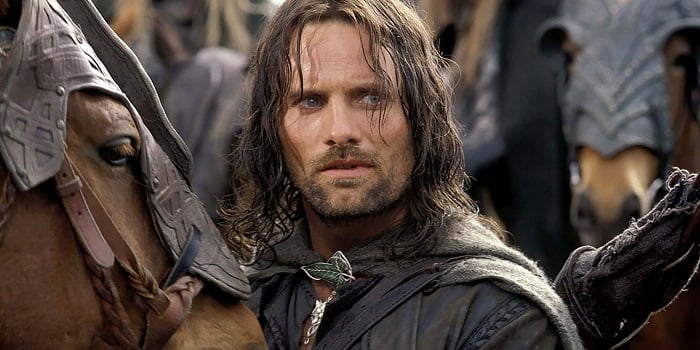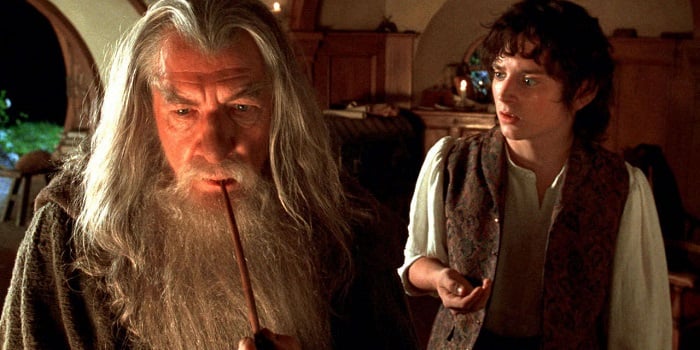The Lord of the Rings is an epic high-fantasy novel written by English author J.R.R. Tolkien. It’s widely regarded as a masterpiece in the fantasy genre and a monumental work in English literature. The story is set in the fictional world of Middle-earth and follows the quest to destroy the One Ring — a powerful and malevolent artifact created by the dark lord Sauron to dominate Middle-earth. However, it should be noted that there are 9 distinct works (and 22 books), some comprising multiple volumes, authored by Tolkien on the Middle-earth universe. These were published both during his lifetime and posthumously (edited by his son Christopher Tolkien).
It’s also worth here noting that while The Lord of the Rings is often referred to as a trilogy in pop-culture, Tolkien originally wrote it as a single novel, which was divided into three volumes by the publisher due to the length and post-war paper shortages — that’s exactly how the three film adaptations were materialized for the big screen. This article provides a comprehensive guide to the chronological order of all The Lord of the Rings books — and by extension, all the books that detail Middle-earth. Ready? Let’s get started!
The Chronological Order of All The Lord of the Rings’ Middle-Earth Books

Since Tolkien’s most widely known publication is The Lord of the Rings (because of the movie adaptations), people often confuse the whole Middle-earth universe with that name. When exploring the chronological order (22 books total) of J.R.R. Tolkien’s Middle-earth universe, the story begins with The Silmarillion, which lays the foundation of the world, covering the creation and the events of the First Age. This is followed by tales set in the same era — The Children of Húrin, Beren and Lúthien, and The Fall of Gondolin.
Unfinished Tales of Númenor and Middle-earth then bridges various periods, offering deeper insights into both earlier and later times. The Hobbit then marks the transition towards the end of the Third Age, setting the stage for The Lord of the Rings trilogy itself, consisting of The Fellowship of the Ring, The Two Towers, and The Return of the King, which take the reader through the climax of the Third Age and the dawn of the Fourth. The Adventures of Tom Bombadil and The History of Middle-earth series (12 books) make the lore richer with further details, spanning over various periods.
Check out Tolkien’s Middle-earth’s books in chronological order:
- The Silmarillion
- The Children of Húrin
- Beren and Lúthien
- The Fall of Gondolin
- Unfinished Tales of Númenor and Middle-earth
- The Hobbit
- The Fellowship of the Ring
- The Two Towers
- The Return of the King
- The Adventures of Tom Bombadil
- The History of Middle-earth (12 volumes)
- The Book of Lost Tales 1
- The Book of Lost Tales 2
- The Lays of Beleriand
- The Shaping of Middle-earth
- The Lost Road and Other Writings
- The Return of the Shadow
- The Treason of Isengard
- The War of the Ring
- Sauron Defeated
- Morgoth’s Ring
- The War of the Jewels
- The Peoples of Middle-earth
The Release Order of All The Lord of the Rings’ Middle-Earth Books


Contrary to what pop-culture made us believe — the release order of Tolkien’s Middle-earth books begins with The Hobbit, which was released in 1937 as a single book. The filmmakers later, for the sake of more detailed storytelling, divided the book into three parts for smart film adaptations. The Hobbit then stage for the epic The Lord of the Rings trilogy, released in the mid-1950s. In 1962, readers were treated to The Adventures of Tom Bombadil. The deeper lore of Middle-earth was then posthumously revealed starting with The Silmarillion in 1977, followed by Unfinished Tales of Númenor and Middle-earth in 1980.
The History of Middle-earth series, comprising 12 volumes, was released between 1983 and 1996 — and it offered an unprecedented look into Tolkien’s creative process. Later, The Children of Húrin came out in 2007, Beren and Lúthien in 2017, and The Fall of Gondolin in 2018. Together, these 22 works constitute the vast, interconnected universe that continues to captivate readers worldwide! There’s also a Letters of J.R.R. Tolkien series, often sold as a set and it offers the author’s personal thoughts about Middle-earth and its lore.
Check out Tolkien’s Middle-earth’s books in order of release:
- The Hobbit (1937)
- The Fellowship of the Ring (1954)
- The Two Towers (1954)
- The Return of the King (1955)
- The Adventures of Tom Bombadil (1962)
- The Silmarillion (1977)
- Unfinished Tales of Númenor and Middle-earth (1980)
- The History of Middle-earth series (12 volumes, 1983-1996)
- The Book of Lost Tales 1 (1983)
- The Book of Lost Tales 2 (1984)
- The Lays of Beleriand (1985)
- The Shaping of Middle-earth (1986)
- The Lost Road and Other Writings (1987)
- The Return of the Shadow (1988)
- The Treason of Isengard (1989)
- The War of the Ring (1990)
- Sauron Defeated (1992)
- Morgoth’s Ring (1993)
- The War of the Jewels (1994)
- The Peoples of Middle-earth (1996)
- The Children of Húrin (2007)
- Beren and Lúthien (2017)
- The Fall of Gondolin (2018)
The Three Lord of the Ring Books That Were Adapted Into Films


The three books of The Lord of the Rings series, adapted into acclaimed films, are The Fellowship of the Ring, The Two Towers, and The Return of the King. The films were directed by Peter Jackson, were critically acclaimed, and brought Tolkien’s epic fantasy to life with remarkable fidelity to the source material, while also making necessary adjustments for cinematic storytelling.
In fact, they’re exactly what made Tolkien’s work a household name. Each film corresponds to its respective book and chronicles the journey of the Fellowship and their quest to destroy the One Ring. The series then concludes the sub-narrative of the larger Middle-earth in the climactic battle for Middle-earth and the ultimate defeat of Sauron in The Return of the King.
